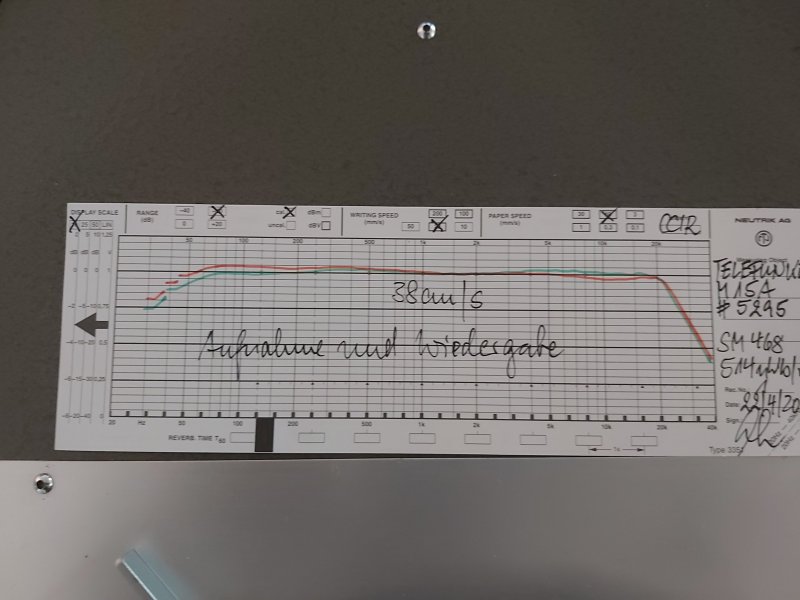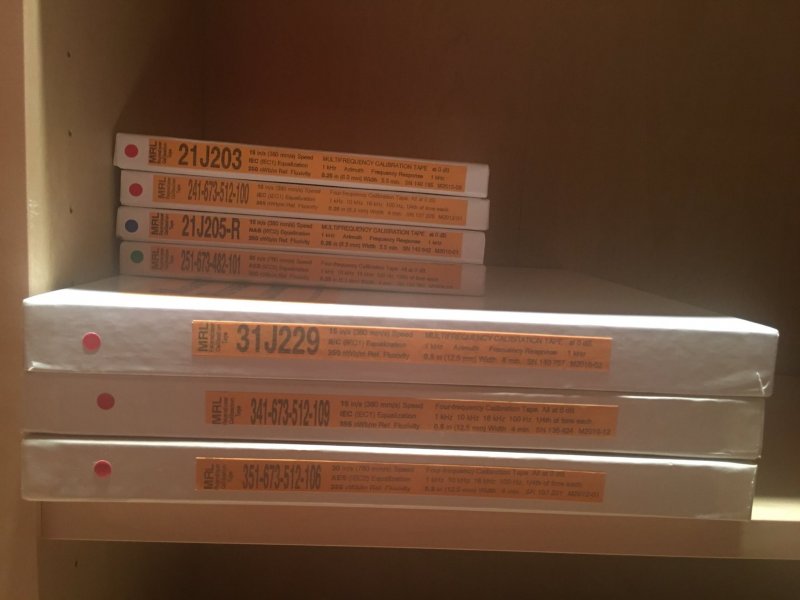For playback on ANY machine, calibration IS relevant!With playback, this isn't relevant. The machine can replay any other tape, as long its the same (mostly ferro) type. But for recording, this is a major difference to compact cassette decks which often can record on cassettes and not having to be calibrated to each manufacturers tape individual.
If tape is so good why does it record so poorly?
- Thread starter Kingrex
- Start date
You are using an out of date browser. It may not display this or other websites correctly.
You should upgrade or use an alternative browser.
You should upgrade or use an alternative browser.
If you don't have test equipment to calibrate your machine both mechanically and electronically, you won't get very good results. You need playback test tapes to calibrate playback electronics plus an oscillator and oscilloscope to align the heads and do record calibration for the type of tape you are recording on. You need to adjust record bias for lowest third harmonic distortion and then high frequency record EQ to get flat record response.
Tape machines have to be calibrated to work with a particular tape. If you look thru their site, you'll see certain tape that has bias characteristics that make it similar to other tape that was used in the studio. Some machines are thus already set up for that tape. But to be sure calibration is recommended.Good to know. How does one understand what tapes are best for what work. Like, what 10.5" tape is for duplication of a tape. What is for recording off a mixing board etc. Thanks
I still have a few sony metal master ceramic cases that still sound good today. yes tandberg unfortunately much expensive today I would not spend 5-6k€ for it.Beautiful machine, and I love it but don't forget how crappy cassettes are!
david
I think you are misinterpreting his statement. It goes without saying that the playback should be calibrated, but that is done using standard test tape, not the tape one is going to play, so that calibration is not tape type specific.For playback on ANY machine, calibration IS relevant!
I asked Dr Burkhardt schwabe this also .
He said calibration is only relevant for recording .
He has worked on every tape machine you can imagine .
He said you have to calibrate the machine for the tape type you will be recording on , if you re gonna record on SM 468 you have to calibrate it for SM 468 , if you gonna record on SM 900 you have to calibrate for SM 900
If that was not the case i wouldnt be able to play a SM 900 etc , i have may be 6 different tape types and i play them all on my telefunken or studers
His credentials
I have 2 machines calibrated for SM 468 and 1 for SM 911
Telefunken M15 A SM 468

He said calibration is only relevant for recording .
He has worked on every tape machine you can imagine .
He said you have to calibrate the machine for the tape type you will be recording on , if you re gonna record on SM 468 you have to calibrate it for SM 468 , if you gonna record on SM 900 you have to calibrate for SM 900
If that was not the case i wouldnt be able to play a SM 900 etc , i have may be 6 different tape types and i play them all on my telefunken or studers
His credentials
About EternalArts | HIfi Audio High End klassisch
audioclassica.de
I have 2 machines calibrated for SM 468 and 1 for SM 911
Telefunken M15 A SM 468

Last edited:
If I receive a tape from the label and they want me to dub it or digitize it, I will calibrate my machines to their test tones and EQ on the playback tape.... at least that's what I do! I'm not going to playback an IEC recorded tape at 355nWb/m on a machine that has been calibrated for NAB at 250!I think you are misinterpreting his statement. It goes without saying that the playback should be calibrated, but that is done using standard test tape, not the tape one is going to play, so that calibration is not tape type specific.
A complete calibration will adjust reproduce amplifier for flat reproduce response from an appropriate test tape; then adjust record bias, level, and EQ for flat record/reproduce response from your chosen tape. After you have this done, you will get best results by sticking with the tape the machine has been calibrated for, although you often can use other tapes with similar oxide formulas with acceptable results.
My Studer was individually calibrated for recording. Thats what I have to choose when recording, the machine has those programmed parameters stored (ditital). But for replay, I don't have to choose any of them, because they are standard ferro type R2R and that has been calibrated by reference test tape.
My Studer was individually calibrated for recording. Thats what I have to choose when recording, the machine has those programmed parameters stored (ditital). But for replay, I don't have to choose any of them, because they are standard ferro type R2R and that has been calibrated by reference test tape.
Last edited:
but "which" reference test tape.... IEC/CCIR, NAB, AES, 200, 250, 320, 355, 520nWb/m... there are a LOT of test tapesBut for replay, I don't have to choose any of them, because they are standard ferro type R2R and that has been calibrated by reference test tape.
Attachments
Last edited:
You get the one that is needed for your machine and the tape EQs that you use. Older machines like the Ampex 351 tube machines are usually calibrated to 250nWb/m, but that is for older tape formulations. If you are running recent tape formulations then you calibrate at a higher output, like 355.but "which" reference test tape.... IEC/CCIR, NAB, AES, 250nWb/m, 320nWb/m, 355nWb/m... there are a LOT of test tapes
You left out the speed.but "which" reference test tape.... IEC/CCIR, NAB, AES, 200, 250, 320, 355, 520nWb/m... there are a LOT of test tapes
But the new tapes from "The Tape Project" are recorded at 250. Think AS is doing theirs at 355.You get the one that is needed for your machine and the tape EQs that you use. Older machines like the Ampex 351 tube machines are usually calibrated to 250nWb/m, but that is for older tape formulations. If you are running recent tape formulations then you calibrate at a higher output, like 355.
I'm just saying... even for the hobbyist, getting tapes from different vendors you will need to calibrate your playback electronics to what you are playing... it's not a one size fits all.
If you don't have test equipment to calibrate your machine both mechanically and electronically, you won't get very good results. You need playback test tapes to calibrate playback electronics plus an oscillator and oscilloscope to align the heads and do record calibration for the type of tape you are recording on. You need to adjust record bias for lowest third harmonic distortion and then high frequency record EQ to get flat record response.
We can carry all these alignments with great accuracy just using a good soundcard and software tools, such as SpectraPlus. And there is a lot of discussion on how to adjust record bias - it depends on the recording priorities.
BTW, nowadays the best way to align test equipment is playing digital test signals using a soundcard!
That's right. So if you'te at 355 for 0VU the tapes based on the older formulas (even if using newer tape) will be at a lower level. No big deal.But the new tapes from "The Tape Project" are recorded at 250. Think AS is doing theirs at 355.
I'm just saying... even for the hobbyist, getting tapes from different vendors you will need to calibrate your playback electronics to what you are playing... it's not a one size fits all.
Yes, its a big deal if you're trying to dub them and you're not getting enough gain. Opposite of that, you calibrate your machine at 250 and the vu is pinned..... I must run my studio differently than you. I want correct calibrations..... geez.... come on. I don't work in "close enough" world!That's right. So if you'te at 355 for 0VU the tapes based on the older formulas (even if using newer tape) will be at a lower level. No big deal.
From what I understand, most people looking at this thread are using studio grade machines at home, not in a studio so this is more about the position of the volume control on a preamp than anything else.Yes, its a big deal if you're trying to dub them and you're not getting enough gain. Opposite of that, you calibrate your machine at 250 and the vu is pinned..... I must run my studio differently than you. I want correct calibrations..... geez.... come on. I don't work in "close enough" world!
Even though modern tape formulations can be recorded at a hotter level, one might prefer the sound recorded at a lower level. For example, for SM468, one can record at 320nWb/m, but I actually prefer 250nWb/m if the recording has a wide dynamic range that pushes the tape close to saturation.
Similar threads
- Replies
- 2
- Views
- 572
- Replies
- 7
- Views
- 345
- Replies
- 3
- Views
- 632
- Replies
- 16
- Views
- 2K
- Replies
- 6
- Views
- 1K
| Steve Williams Site Founder | Site Owner | Administrator | Ron Resnick Site Owner | Administrator | Julian (The Fixer) Website Build | Marketing Managersing |


